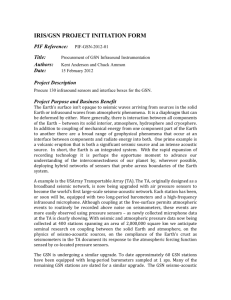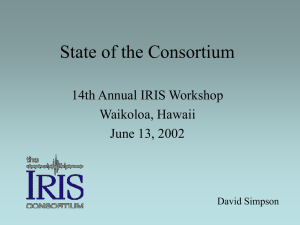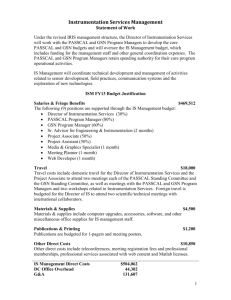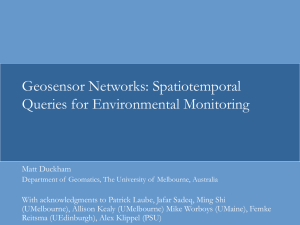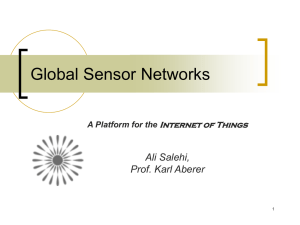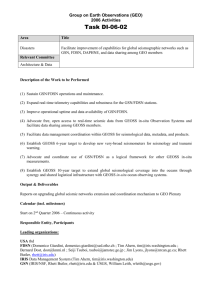Hafner_2015TATeam
advertisement
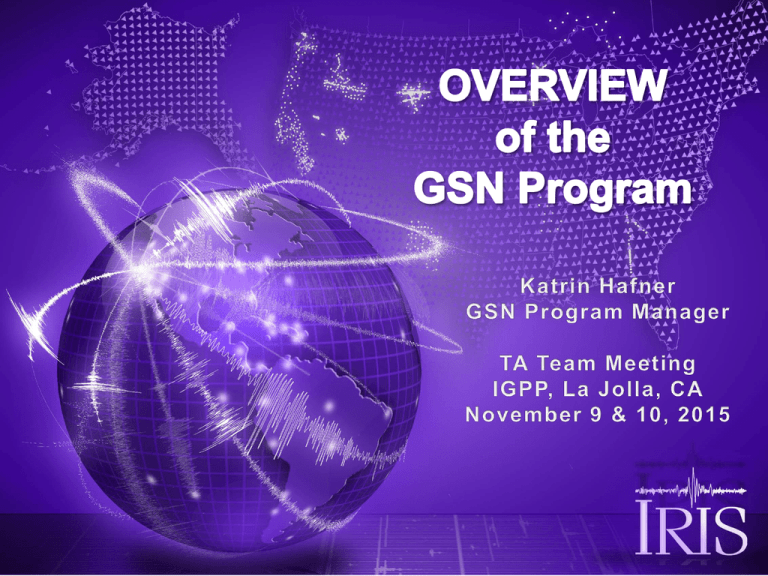
Key foundational element of IRIS NSF funded the construction of the GSN (DoD funds also) Beginning in 1998 USGS line item for GSN established to take over operations Periodic recapitalization funds 3 • The GSN is operated as a partnership between IRIS and USGS • IRIS’ GSN activities are funded via NSF – Five year Cooperative Agreements – GSN is part of the FY14-FY18 award: Seismological Facilities for the Advancement of Geoscience and EarthScope (SAGE) • IRIS provides GSN Program Manager • IRIS/IDA component of the network is primarily operated via a subaward to Project IDA – Field operations – Data Collection Center 4 • • • • • • High dynamic range Broadband (hrs to ~10 Hz) Quiet instruments / sites / installations Real-time telemetry Global distribution at ~ 2000 km spacing Well-characterized instrument response 6 • National Earthquake Information Center usage Rapid determination of size and location of major earthquakes Provides comprehensive catalog of EQ source info • Tsunami warning ~100 GSN stations are used for real-time analyses by the NTWC; coverage in oceans and international areas is key – sparse coverage by other networks • Verification seismology (CTBTO) ~50 auxiliary seismic stations are contributed by GSN • GSN is itself a partnership – NSF, USGS & IRIS Other US government contributions have bolstered support and reinvestment in the GSN for its multi-use capabilities (monitoring) • Dept of Defense • Dept of Energy • Dept of State • Host country partnerships MOUs between foreign governments, private entities & universities Long-standing relationships between network operators and local personnel • National agencies NOAA, NEIC, PTWC, NTWC – data flow & delivery • International agencies FDSN partners for improved coverage (GEOSCOPE, GEOFON, etc.) CTBTO interactions, training, etc. Simiganch, Tajikistan (SIMI): LLNL provided funding to IRIS for equipment and installation costs MOU with Tajiks in place Site mods (bridge, power, doors) to be done by Tajiks IDA assembled equipment; shipment now in Dushanbe Installation projected for May2016 ARRA funding ARRA funding KS54000 M2166-VBB • Review Design Goals in light of current research & monitoring requirements • Return GSN to full funding levels, & continued cost-effective operations • Review recent technology developments and quantify costs and benefits • Maintain strong community oversight of GSN • Sustain emphasis on data quality • Strengthen international partnerships • Ensure continued close integration between data collection, archiving and distribution • Continue the dual-operator, academic/government partnership between NSF/IRIS and the USGS PRIMARY GOALS: Replacement of data acquisition equipment (essentially complete) Replacement of the primary borehole sensors (prototype sensor in development) Replacement (as needed) of primary vault sensors; Repair/replacement of infrastructure Strategic relocation or infill of station sites ( e.g. Tajikistan and Uzbekistan stations) Facilitate – Collaborate – Educate • Provide technical advice and leadership in the development and evolution of the GSN Program – Interface with IRIS governance (GSN Standing Committee, etc.) – Interface with IRIS management (IRIS President, Instrumentation Services Director, etc.) – Interact with the leadership of the US Geological Survey – Guide and encourage instrument development – Pursue external funding resources, particularly for GSN recapitalization • Manage the GSN Program including – Program technical, cost, schedule responsibilities • Serve as the primary interface between GSN and the user 20 community SUSTAINED OPERATIONS on SEA FLOOR Map showing existing GSN& FDSN station distribution. Contoured values show the number of GSN stations within 10 degrees of each point Facilitate – Collaborate – Educate GSN RESILIENCE • Technical Redundancy and robust field systems, power and communications Diversity in communications infrastructure • Operational Efficiency and optimization of station operations o Both ASL and IDA continue making improvements to efficiencies in network operations, and share techniques and procedures o Standardization of equipment allows us to approach cross-training between networks (GSN and beyond). • Funding Continue cultivating financial support from non-NSF/USGS GSN users • International Partnerships Facilitate – Collaborate – Educate SUMMARY GSN design goals have largely been met (except for oceans) Large volumes of data are fully archived and distributed Management & operational partnership serves both the scientific research and monitoring communities Improved data quality is an area of significant focus, and tools are being shared Network is resilient as a result of operational structure, multiple sensors and telemetry paths and multiple DCCs Facilitate – Collaborate – Educate MODELS FOR FUNDING: Stable funding is critical to ensure basic network operations result in high-quality observations. The current model: Periodically, core NSF and USGS Funding has been augmented by funds from the DOE, DOD, DOS to enable the recapitalization of the network. • PROS Easier to get funding for recapitalization than for O&M Engages the science community; reaffirms GSN needs and objectives • CONS no “guarantee” of sufficient budget to maintain high level of operations Facilitate – Collaborate – Educate GSN DATA ARCHIVING & DISTRIBUTION All GSN data are freely and openly available, and provided in near real-time. All GSN data flow into the DMC via the GSN DCCs Facilitate – Collaborate – Educate AVERAGE USGS GSN COSTS MAJOR CATEGORIES AVERAGE EXPENDITURES/YEAR over LAST 5 YEARS GSN station O&M $ 2,889,732 Data QC $ 620,997 ASL Facilities $ 311,418 Instrument Testing $ 299,778 Total $ 4,121,925 USGS NET ALLOCATIONS WAS $4.2M, BUT DECREASED TO $3.9M in FY13 AND HAVE REMAINED FLAT SINCE THEN Facilitate – Collaborate – Educate Working with the European Data Centers to modernize data distribution • CoopEUS Project – Adoption of FDSN standard web services • Europe – ETHZ, RESIF, INGV, GFZ, ORFEUS-DC • US – NCEDC, IRIS DMC – Will allow us to promote FDSN web services to other parts of the globe – IRIS DS supported the incorporation of FDSN web services into SeisComp3, the Seattle version • Federation (time for a modern NetDC) – Supports distributed data center concepts advocated by some of the larger FDSN centers – Still allows smaller networks to rely on larger centers for backup or primary data center functions • Federation in practice – IRIS has developed an IRIS Federator – Intend to take the Federator concept to the FDSN Facilitate – Collaborate – Educate IMPACTS on SCIENTIFIC RESEARCH • Imaging of Basic Earth Structure GSN station coverage has increased resolving power, e.g. Shear Wave Velocity Models Studies provide input into understanding of geodynamics, tectonics and understanding of large EQs Facilitate – Collaborate – Educate GSN DATA ACCESS METHODS • Data distribution statistics attest to effectiveness Facilitate – Collaborate – Educate
